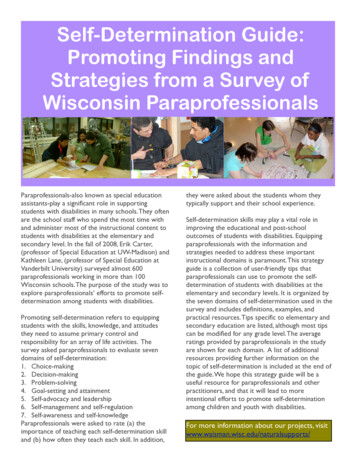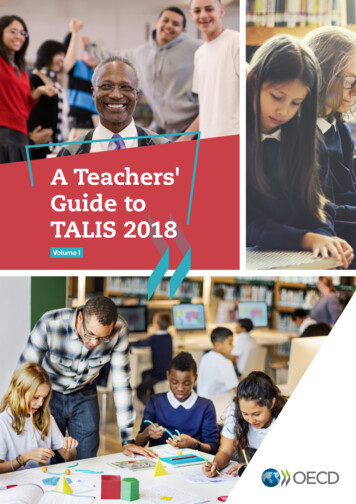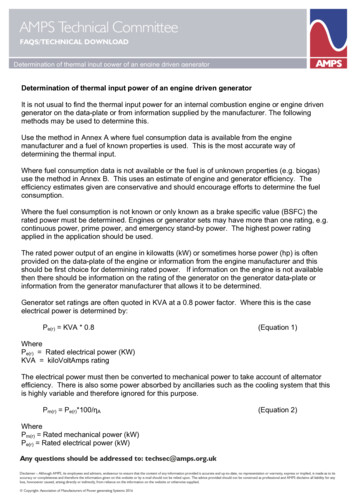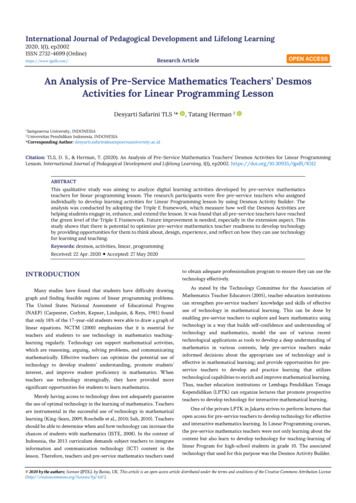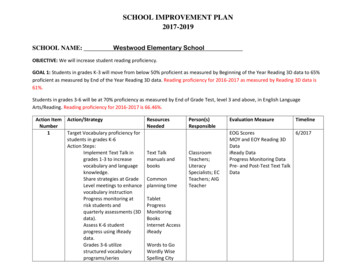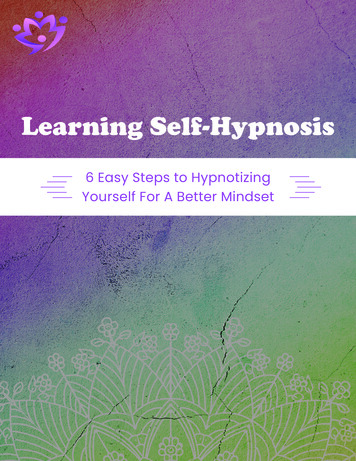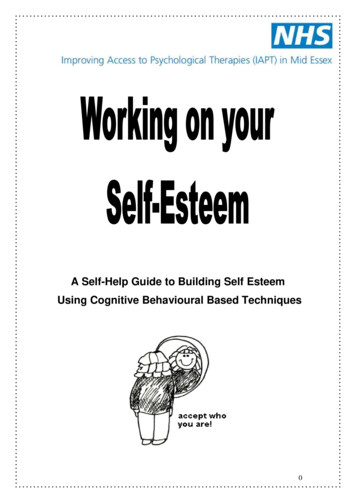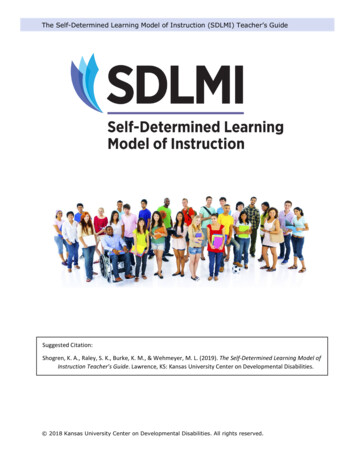
Transcription
The Self-Determined Learning Model of Instruction (SDLMI) Teacher’s GuideSuggested Citation:Shogren, K. A., Raley, S. K., Burke, K. M., & Wehmeyer, M. L. (2019). The Self-Determined Learning Model ofInstruction Teacher’s Guide. Lawrence, KS: Kansas University Center on Developmental Disabilities. 2018 Kansas University Center on Developmental Disabilities. All rights reserved.
The Self-Determined Learning Model of Instruction (SDLMI) Teacher’s GuideTable of ContentsIntroduction . 3Teacher’s Guide to Implementing the SDLMI . 3Defining Self-Determination . 3Research on the SDLMI . 4Self-Determination Inventory System (SDIS) . 5Self-Determined Action Framework . 5Introduction to the SDLMI . 6How is the SDLMI used?. 7SDLMI Frequently Asked Questions (FAQs) . 8How does the SDLMI work? . 11SDLMI Implementation Description. 12Tips on Working through the SDLMI Phases . 13Preliminary Conversations . 14Define Self-Determination . 14Discuss Key Terms used throughout the Problem-Solving Process . 14Describe Teacher and Student Roles . 15Troubleshooting and the SDLMI . 16SDLMI Phase Flow Charts . 18Alternate Phrasing for Student Questions . 22Educational Supports . 23Whole-Class Implementation of the SDLMI Case Study: Ms. Whitmoore and Mr. Elliott. 32Whole-Class Implementation of the SDLMI Case Study: Luca . 36Transition Planning Implementation of the SDLMI Case Study: Jordan . 40Implementation of the SDLMI with a Student with Significant Support Needs Case Study: Amy . 44Example Student Question Guides . 48Blank Student Question Guides . 59Suggested Self-Determination Resources. 63References . 662
The Self-Determined Learning Model of Instruction (SDLMI) Teacher’s GuideIntroductionTeacher’s Guide to Implementing the SDLMIThis Teacher’s Guide describes The Self-Determined Learning Model of Instruction (SDLMI) and howteachers and other school personnel can use the model to support students with or without disabilitiesto: Learn and use skills that enable them to self-regulate problem solving, leading to goal settingand attainment Identify meaningful learning goals across multiple curricular domains Make progress toward goals across multiple curricular domains Achieve more positive school and post-school outcomes Become more self-determinedDefining Self-DeterminationBeing self-determined is about acting as the causal agent in one’s life (Shogren et al., 2015). Causalagents have the skills and attitudes that enable them to make or cause things to happen in their lives.People who are self-determined self-initiate and self-regulate their actions to solve problems, makedecisions, and set goals that impact their lives. Adolescents become more self-determined as theyidentify their interests and preferences, set and work toward goals aligned with those interests andpreferences, engage in problem solving and decision making as they encounter barriers in workingtoward their goals, and advocate for themselves and their needs. These actions are critical for allstudents and are often embedded across the curriculum. However, students need support to learn andpractice these skills in an integrated way if they are to lead self-determined lives.3
The Self-Determined Learning Model of Instruction (SDLMI) Teacher’s GuideResearch on the SDLMIResearch over the last 25 years has shown that teachers can use the SDLMI to enable students with andwithout disabilities to reach goals while they are in school and after they finish school. Over 20 researchstudies have shown the impact of the SDLMI on outcomes, establishing it as an evidence-based practiceto promote self-determination (Hagiwara, Shogren, & Leko, 2017; Lee, Wehmeyer, & Shogren, 2015;National Technical Assistance Center on Transition, 2016). A selection of several recent studies is below.Selected Research on the SDLMIAuthorsRaley,Shogren, e14 to 16years old Shogren,Palmer,Wehmeyer,WilliamsDiehm, &Little (2012)312Shogren,Wehmeyer,Palmer,Rifenbark, &Little (2015)779Wehmeyer etal. (2012)31213 to 21years old 14 to 21years old 13 to 21years old Set and achieved academic-related goals with the SDLMIover 16 weeks in an inclusive, general educationclassroom including students with and withoutdisabilitiesHigh levels of goal attainmentStudents who learned using the SDLMI showedsignificantly higher goal attainment over the course of aschool year than peersStudents who learned using the SDLMI showedsignificant increases in access to the general educationcurriculumMultiple interventions to promote self-determination,including the SDLMI, were available to studentsthroughout high schoolSelf-determination status during the final year of highschool predicted more positive employment outcomesone-year post-school and community participation oneand two years post-schoolStudents with access to the SDLMI showed moresignificant increases in self-determination after twoyears of interventionNote. A range of students with and without disabilities were included across studies. Disabilitycategories represented in one or more studies include: Autism Spectrum Disorder, EmotionalDisturbance, Hearing Loss or Deafness, Intellectual Disability, Multiple Disabilities, OrthopedicImpairment, Other Health Impairment, Specific Learning Disability, Speech or Language Impairment, andVision Loss or Blindness.More information on research on the effectiveness of the SDLMI is available at: www.selfdetermination.org.4
The Self-Determined Learning Model of Instruction (SDLMI) Teacher’s GuideSelf-Determination Inventory System (SDIS)The Self-Determination Inventory System (SDIS) is comprised of two validated measures of selfdetermination, the Self-Determination Inventory: Student Report (SDI:SR) and the Self-DeterminationInventory: Parent/Teacher Report (SDI:PTR).Researchers, school districts, schools, and teachers can use the SDIS concurrently with SDLMIimplementation to:(1) Identify areas of strength and areas in need of instruction(2) Track students’ progress in the development of self-determination skills over time(3) Report student, classroom, school and district self-determination status and outcomesLearn more about the SDIS measures at www.self-determination.org.Self-Determined Action FrameworkBoth the SDI:SR and the SDI:PTR align with our theoretical framework for the development of selfdetermined action:5
The Self-Determined Learning Model of Instruction (SDLMI) Teacher’s GuideIntroduction to the SDLMIThe SDLMI is a teaching model implemented by teachers to enable their students to self-direct and selfregulate their actions in pursuit of goals.SDLMI implementation:The SDLMI is intended to be used by general and special education teachers and school professionals across avariety of academic (e.g., English, Math) and non-academic (e.g., social, behavioral, transition planning) areasto enable students to become more effective at initiating and self-regulating their actions as they work towardself-selected goals.Teachers enhance their practice:As a model of instruction, the SDLMI is designed to guide teachers in supporting students to achieve their selfset goals and develop skills associated with self-determination (e.g., problem solving, self-evaluating). TheSDLMI supports teachers in learning how to shape their practices to provide students opportunities to developand practice using skills associated with self-determination.Students strengthen their self-determined actions:When provided explicit instruction on skills associated with self-determination and opportunities to practiceand use those skills, students are enabled to use self-determined actions and achieve goals they set forthemselves, achieving greater academic and social-emotional outcomes.Improved student outcomes:Through the iterative process of teachers enhancing their practice and students using self-determined actions,positive student outcomes result (e.g., academic achievement, postschool competitive employment and highereducation).6
The Self-Determined Learning Model of Instruction (SDLMI) Teacher’s GuideThe SDLMI has three distinct phases that are each associated with a problem the student must solve: In Phase 1, the teacher supports the student to identify and set a goal to solve the problem of:What is my goal? In Phase 2, the teacher supports the student to develop an action plan to achieve the goal theyset in Phase 1 and identify a self-monitoring process to implement to solve the problem of:What is my plan? In Phase 3, the teacher supports the student to evaluate their progress toward the goal theyidentified in Phase 1 and planned to achieve in Phase 2. The student determines if they achievedtheir goal and need to set a new goal or if they need to revise their goal or develop a new actionplan. In Phase 3, the student solves the problem of: What have I learned? Based on what the student learns in Phase 3, they will decide to cycle back to Phase 1 of theSDLMI to set a new goal or revise their current goal or to Phase 2 develop a new action plan fortheir current goal. The SDLMI is meant to be a cyclical process, meaning that students will workthrough Phases 1, 2, and 3 repeatedly, creating more opportunities to build and practice usingself-determined actions.How is the SDLMI used? In each phase, there are four Student Questions (12total) that lead students through a problem-solvingsequence to solve the problem posed in that phase. Each Student Question (12 total) is linked to TeacherObjectives that provide a roadmap for teachers onhow to support students in answering each StudentQuestion. There are Educational Supports within each phasethat teachers can use to provide instruction tostudents as they work to answer the StudentQuestions.7
The Self-Determined Learning Model of Instruction (SDLMI) Teacher’s GuideSDLMI Frequently Asked Questions (FAQs)What kinds of goals will my students set with the SDLMI?Examples of goals related to academic achievement: Building content-specific skills (e.g., English skills) Being prepared for class (e.g., bringing books,doing homework) Improving skills that support academicachievement (e.g., note-taking, organization)Examples of goals related to personal achievement: Building personal skills (e.g., nutrition or exercisegoals) Participating in extracurricular activities (e.g.,band, clubs) Volunteering or getting community service experienceExamples of goals related to post-school endeavors: Researching higher education (e.g., enrolling in college/university classes) Securing competitive employment (e.g., identifying careers that are of interest or internshipopportunities) Participating in community activities and services (e.g., joining a community group, exploringresources in the community)How can the SDLMI support my students’ academic achievement? Skills associated with self-determination increase academic achievement and progress. Teachersare often already targeting these skills indirectly and the SDLMI formalizes the process. Below is an example of the alignment of 9th/10th English/Language Arts (ELA) Common CoreState Standards (CCSS) and skills associated with self-determination.8
The Self-Determined Learning Model of Instruction (SDLMI) Teacher’s GuideSDLMI FAQs (continued)How can the SDLMI be incorporated into transition planning? As teachers collaborate with students to prepare for their transition from high school to adultlife, the SDLMI can be a valuable tool for setting goals around future employment, education, orcommunity life. Students can set goals that are integrated into transition planning materials, likeIndividualized Education Programs (IEPs) or Individualized Plans for Employment (IPEs). Some students may also use the SDLMI to plan for the role they wish to take on within transitionplanning teams through developing their leadership, communication, and self-advocacy skills. Check out the SDLMI Teacher’s Guide Supplement: Implementing the SDLMI to EnhanceTransition Planning for more guidance at: www.self-determination.org.How much time will implementing the SDLMI take? When implemented with the whole class, materials are designed so that teachers can embed15-minute lessons twice a week on skills related to the SDLMI (e.g., identifying a goal, solving aproblem). For more information on whole-class implementation, see the SDLMI Teacher’s GuideSupplement: Implementing the SDLMI with the Whole Class at: www.self-determination.org. When implemented one-on-one or in small groups, often with students with more significantsupport needs, teachers can provide instruction for 15-30 minutes twice a week supportingstudents to work through the SDLMI phases, often during time dedicated to individualized goals(e.g., IEP goals) or transition planning. See the SDLMI Teacher’s Guide Supplement: SupportingStudents with Complex Communication Needs to Engage with the SDLMI at: www.selfdetermination.org. Because the SDLMI is highly individualized based on the student and class needs, there can bevariability in the time devoted to supporting its implementation based on student and classsupport needs.How can I infuse the SDLMI outside of explicit SDLMI instruction? Teachers should infuse key words and prompts to think about goals during all instruction. Thissupports students to continue to focus on their goals and implementing their action plans. Students will work towards goals during regular content instruction and monitor their progressusing their action plans. It is important to remember that when using the SDLMI, teachers support students, butstudents self-direct the process.9
The Self-Determined Learning Model of Instruction (SDLMI) Teacher’s GuideSDLMI FAQs (continued)Who can benefit from the SDLMI? All students! The SDLMI is designed to be individualized to student needs, and thus teachers canenable students with a range of support needs, including those with the most extensive supportneeds, to set and go after goals using the SDLMI. When implementing the SDLMI with students with significant support needs, teachers areencouraged to build upon cognitive and communication supports the student is familiar with,such as visual representation of concepts (e.g., goal, plan) or assistive technology. See theSDLMI Teacher’s Guide Supplement: Supporting Students with Complex CommunicationNeeds to Engage with the SDLMI at: www.self-determination.org.How can I implement the SDLMI in culturally responsive ways? The SDLMI is flexible and can incorporate students’ cultural and linguistic contexts. Involving families in the SDLMI process will allow teachers to integrate a family’s uniquepreferences, beliefs, and values into the SDLMI process. Teachers can open a dialogue aboutself-determination with families through written communication or in-person meetings, andincorporate this information as they support students to go after their self-selected goals.Do I implement the SDLMI by myself or can I work with other people? Teachers can collaborate with other teachers, school professionals (or related service providers),peer mentors, family members, and students to implement the SDLMI most effectively! Teachers primarily provide explicit instruction on skills associated with self-determination, andtheir instruction is informed and supported by other people who support the student in avariety of contexts (e.g., home, extracurricular activities).How long do I need to implement the SDLMI? By progressing through the phases of the SDLMI over and over again with multiple goals,students strengthen their self-determination. So, the more opportunities and repetition, thebetter!10
The Self-Determined Learning Model of Instruction (SDLMI) Teacher’s GuideHow does the SDLMI work?Phase 1: Set a Goal The teacher follows the Teacher Objectives for each Student Question thatguide them in how to support students in determining their goal The teacher provides Educational Supports (e.g., teaching choice-making skills,engaging in strengths assessments) By meeting Teacher Objectives, the teacher enables students to answer thefour Student Questions and solve the problem of Phase 1, What is my goal?:1. What do I want to learn?2. What do I know about it now?3. What must change for me to learn what I don’t know?4. What can I do to make this happen?Phase 2: Take Action The teacher follows the Teacher Objectives that guide them in how tosupport the student in developing and enacting an action plan The teacher provides Educational Supports (e.g., how to self-instruct,how to self-monitor) By meeting Teacher Objectives, the teacher enables students to answerthe four Student Questions and to solve the problem of Phase 2, Whatis my plan?:5. What can I do to learn what I don’t know?6. What could keep me from taking action?7. What can I do to remove these barriers?8. When will I take action?Phase 3: Adjust Goal or Plan The teacher follows the Teacher Objectives that guide them in how to supportthe student in determining what they have learned The teacher provides Educational Supports (e.g., how to self-evaluate) By meeting Teacher Objectives, the teacher enables students to answer thefour Student Questions and to solve the problem, What have I learned?:9. What actions have I taken?10. What barriers have been removed?11. What has changed about what I don’t know?12. Do I know what I want to know?11
The Self-Determined Learning Model of Instruction (SDLMI) Teacher’s GuideSDLMI Implementation DescriptionThe SDLMI can be implemented in a variety of settings with students with and without disabilities.Below is information on key considerations for teachers when implementing the SDLMI. Moreinformation on implementing the SDLMI with a whole class, with students with complex communicationneeds, and as a part of transition planning can be found in the SDLMI Teacher’s Guide Supplements at:self-determination.org. Planning and SchedulingThe frequency and duration of instruction will vary based upon the setting and students’support needs. Consider creating a schedule to provide instruction on skills related to selfdetermination approximately twice per week, while recognizing that the amount of time persession should be individualized based on the curricular content of your class.The supplement for whole-class implementation includes a sample schedule, while thesupplement for implementation with students with complex communication needs providesstrategies for supporting students with complex communication needs to follow the sequenceof Student Questions. Instructional StrategiesThe SDLMI is a teaching model designed to be overlaid on existing curriculum, and as such,teachers should plan instruction and activities tailored to the unique strengths and needs oftheir students. Considerations for instructional strategies will vary depending upon the context.During whole-class implementation, students may benefit from multiple instructional formats(e.g., think-pair-share, whole-class discussions). When implementing the SDLMI with studentswith complex communication needs, the teacher may choose activities to make the conceptsmore concrete and linked to communication methods that the student is already familiar with.Teachers supporting students during transition planning may embed instruction related to theSDLMI in activities such as career interests assessments, job exploration, or communityinvolvement.See the following SDLMI supplements for additional information about SDLMI implementation: Supporting Students with Complex Communication Needs to Engage with the SDLMI Implementing the SDLMI to Enhance Transition Planning Implementing the SDLMI with the Whole Class12
The Self-Determined Learning Model of Instruction (SDLMI) Teacher’s GuideTips on Working through the SDLMI PhasesSTUDENT VOICESupport the student to answer the Student Questions. Make sure the student’sresponses are document in some form (e.g., written, pictures, audio recorded). Keep thefocus on the student and their self-initiation of the process.DISCUSSIONRemember this process is always a conversation and not simply a matter of respondingto a question and writing the answer.SUPPORTSRefer to the Teacher Objectives and Educational Supports (see p. 19, 23). When possible,support students to use student-directed Educational Supports (e.g., self-reinforcement,choice making, etc.).PRACTICEStudents should initially practice progressing through the 12 Student Questions with agoal that can be completed in a short period of time (2-4 weeks). This goal could focus onengaging in a recreational activity, doing a social activity, or another area based on thestudents’ interests. Teachers then support students to continue to use the SDLMI to setmore complex goals over time. This reinforces the idea that students will use the SDLMIquestions on a continuous basis throughout their lives to set and achieve their goals.MOTIVATIONFollowing the initial “practice” goal, work on one goal in a high-interest area so thestudent finds it easier to focus, be more productive, and have a more satisfyingexperience using the SDLMI. The goal should be one that the student selects (withguidance from the teacher).CYCLEThe SDLMI supports students in cycling through goal setting and action planning severaltimes as they rethink strategies and assess progress. Rather than a straight line, thejourney a student takes may weave back and forth through the phases of the model asthey determine the desired goal and most effective action plan to achieve their goal.ADAPTATIONWhen students self-evaluate progress toward the goal (Phase 3), they may set a morecomplex or more narrowly-focused goal that targets what they really want to learn, butwere not initially able to pinpoint. This adaptation is a crucial part of the process andpromotes the development of self-regulatory skills and behavioral flexibility.ENCOURAGEMENT When students are evaluating the progress they have made towards a goal, teachers cansupport them to focus on success and emphasize that revising goals and action plans is apart of the process and not an indication of not being successful, but instead it is a way tolearn and grow.13
The Self-Determined Learning Model of Instruction (SDLMI) Teacher’s GuidePreliminary ConversationsThrough a series of conversations or mini-lessons (brief, 15-minute lessons), teachers can explain thatthe purpose of the SDLMI is for teachers and students to work collaboratively to learn how to solveproblems, set goals, and learn what they need to know to get what they want in life. It is important toremember that: Mini-lessons allow teachers to provide content instruction on skills associated with selfdetermination in a relatively short period of time, and then create opportunities for ongoingpractice as these skills are embedded in ongoing instructional activities. Student needs may vary, but all students can succeed with the right supports. Teachers should only provide as much support as is necessary for the student to succeed, andfade support or identify other supports (e.g., technology, peers) as the student gains expertise. Teachers can use effective listening techniques such as restating what the student is expressingto promote greater engagement and collaboration.Define Self-DeterminationBefore beginning the SDLMI, it can be helpful for students to come up with a shared understanding ofwhat self-determination is and how all people use self-determined actions in their lives to set andachieve their goals. Teachers can use the following student-friendly definition:Being self-determined means acting or causing things to happenas you set and work toward goals in your life.Discuss Key Terms used throughout the Problem-Solving Process14
The Self-Determined Learning Model of Instruction (SDLMI) Teacher’s GuideDescribe teacher and student rolesWhen teachers use the SDLMI, they take on multiple roles FacilitatorTeachers are facilitators of the process in that they do what it takes to enable students tosucceed by using the Teacher Objectives and Educational Supports and enabling students togrow and develop their self-determined actions.InstructorTeachers are instructors because they deliver instruction that enables students to answerthe questions and complete tasks identified in the Teacher Objectives.AdvocateTeachers act as advocates by letting students know they can succeed, by removing barriersin the environment, and by working with the student to achieve shared goals.When students receive instruction with SDLMI, they take on multiple roles Self-Directed LearnerStudents self-direct the learning process. Note that self-direction is not the same asindependent performance – we all need supports to make progress toward goals. TheSDLMI helps teachers to support students to actively engage in the process and, in so doing,more actively direct and initiate their learning.Active LearnerStudents are active learners in that they act in collaboration with the teacher and grow intheir direction over the learning process.Self-AdvocateStudents self-advocate by communicating interests, preferences, beliefs, and goals.15
The Self-Determined Learning Model of Instruction (SDLMI) Teacher’s GuideTroubleshooting and the SDLMIScenarioA student doesn’t wantto work on a goalrelated to the classcontent.A student identifies agoal that is too longterm, making it difficultto attain.When implementedwith a large class, ateacher is overwhelmedwith the variety of goalsthat students set.A teacher has explainedwhy promoting selfdetermination isimportant to the family,but they are unsureabout how to supportself-determination athome.A student’s family isunsure of goals theirchild is working on inclass.Suggested StrategyFor the first goal, teachers cansupport students to pick a goaloutside of the class content topics(e.g., extracurricular activities,hobbies) to enhance motivation.Teachers should discuss options ofpossible short-term goals that wouldsupport the student in meeting thelong-term goal (e.g., checking out abook from the library to learn about acareer in photography). Teachers canalso focus on the learning process andsupport students to recognize thedifference between short- and longterm goals as they work through theSDLMI, especially Phase 3.Teachers can select broad goal area“buckets” for students to target aspecific goal within to supportindividualized goals that still relate toclass content. This will benefit allstudents and make tracking and classconversations easier.Positive OutcomeThis strategy sets the stage forstudents to be more engaged inthe goal-setting process becauseit is about a goal that they areinterested in.By offering short-term goalsuggestions and examples, theteacher provides the studentwith an idea of how a short-termgoal can be in service of a larger,long-term goal.The teacher provide studentswith opportunities toindividualize their goals but stilllimits the range of goal areas totarget content in the classroom,making goal setting andevaluation manageable across allstudents in the class.Teachers can take time to listen to the The teacher and family partner tofamily’s interests related toidentify goal areas and possi
The Self-Determined Learning Model of Instruction (SDLMI) Teacher’s Guide . 3 . Introduction . Teacher’s Guide to Implementing the SDLMI . This Teacher’s Guide describes . The Self-Determined Learning Model of Instruction (SDLMI) and how teachers and other school personnel can use the m
